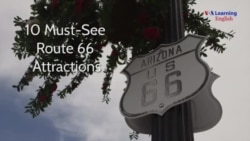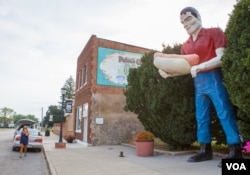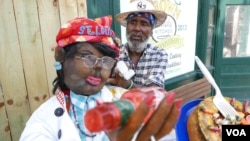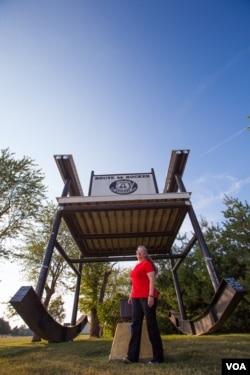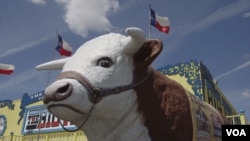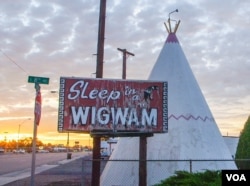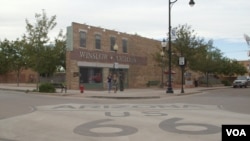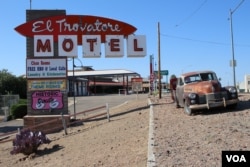The United States is full of odd roadside attractions. Route 66 is home to some of the oldest – and arguably most bizarre – roadside attractions of them all. Here are 10 attractions you should see along the Mother Road:
Paul Bunyan and a Hot Dog
Route 66 travelers pass by many fiberglass giants right along the road. These giants were a popular form of advertising in the 1960s. Many of them stood in front of service stations. They held car parts, such as mufflers. The collection of Route 66 giants became known as “Muffler Men.” Businesses hoped the strange statues would get travelers’ attention.
The first fiberglass giant was a “Paul Bunyan” figure, built in the early 1960s. Paul Bunyan is a famous lumberjack in American folklore.
It originally advertised the Paul Bunyan Cafe on Route 66 in Flagstaff, Arizona. There, the Paul Bunyan statue held an axe.
But in 1965, a man in Illinois bought the statue and brought it to his state. He used the giant Paul Bunyan to advertise his restaurant in Cicero, Illinois. He also replaced the axe with something very different: a hot dog.
The statue was moved again in the early 2000s, this time to Atlanta, Illinois. Paul Bunyan still stands there today, nearly six meters tall, with one giant hot dog in hand.
Crown Candy Kitchen and Jamaica Ray
Crown Candy Kitchen has been serving Route 66 travelers from the very beginning. It is just a few short blocks from the 66 path through St. Louis, Missouri. The family-run soda fountain shop opened more than 100 years ago, and has been making candies, malts, and meals ever since.
On weekends, people sometimes wait in line for a table at Crown Candy for over an hour. Luckily there is free entertainment right outside. Jamaica Ray, a local folk artist, creates unusual sculptures.
Jamaica Ray was born in St. Louis, Missouri, but was raised in Jamaica. When he returned to his birth city a few years ago, he brought with him a unique style of art. Jamaica Ray creates very life-like sculptures out of cloth, plastic and other materials he finds. And he plays music for customers on his homemade steel drums.
The World's Largest Rocking Chair
Fanning, Missouri, is home to one of the strangest Route 66 attractions. Just off the road sits an almost 13-meter-tall rocking chair.
The structure was completed in 2008 on the first of April, or April Fools Day. The same year, the Guinness Book of World Records awarded it the title of “World’s Largest Rocking Chair.”
At one time the chair actually rocked. But officials decided it had to be permanently still to be safe. People are not permitted to climb the chair. We suspect, however, that it probably happens once in a while when no one is watching.
Big Texan's Steak Challenge
Few places better represent the common expression “Everything’s Bigger in Texas” than the Big Texan Steak Ranch. Since 1960, it has appealed to travelers with big appetites -- and a big love of beef.
It is hard to miss the huge yellow restaurant -- or the giant cow statue that sits out front. The cow advertises Big Texan’s special deal, and what has made this steak ranch famous: a “free” 72-oz -- or 2 kilogram -- steak. There is one trick: the steak is only free if you can eat the entire thing in one hour.
A special table is in the middle of the restaurant for the daring diners who accept the challenge. Since 1990, more than 9,000 diners have eaten the entire 2-kilogram steak.
Cadillac Ranch - A Colorful Burial Ground for Cars
Of all the strange attractions along the Mother Road the best known is in Amarillo, Texas: Cadillac Ranch
There, ten Cadillac cars are partly buried, front first, in the hard, flat earth. Their back ends, several with iconic tail fins, point toward the big Texas sky.
A group of artists called Ant Farm created the installation in 1974. It is on private land but the owner has always left the area open for visitors. The installation is meant to represent the golden age of cars.
Huge numbers of tourists visit Cadillac Ranch every day. Many bring along cans of spray paint. Visitors are encouraged to leave their marks on the colorful cars.
Beautiful Blue Swallow
Some of the most treasured attractions on Route 66 are motels. Bright neon motel signs transport the traveler back in time. These motor court-style motels became popular as the automobile rose to importance in the U.S. The small, independent motels remain a symbol of the American road trip.
Along Route 66 today, the majestic Blue Swallow Motel in Tucumcari, New Mexico, stands out. The Blue Swallow opened in 1940. It has been renovated and modernized. But it still has many of motel’s classic and original features. A vintage car still sits out front.
Blue Swallow’s sign, though, is what makes it so special. The photogenic neon sign features a swallow -- a type of bird -- with a leaf in its beak. The bird’s lights blink on and off.
Route 66 travelers today can still stay the night in one of Blue Swallow’s 12 rooms. It remains one of the most famous motels along the route.
What is a Wigwam?
Some of Route 66’s motels are just kooky. The Wigwam Village in Holbrooke, Arizona, is an example. Wigwam villages are motels built in America beginning in the 1930s. They were designed to look like traditional Native American homes. Each room is actually a separate building, tall and cone-shaped.
However, that kind of Native home is actually called a tipi. Native wigwams are short and round like a dome.
The builders may have gotten the name wrong, but visitors loved the motels anyway. And the Wigwams remain a popular Route 66 attraction.
Take It Easy on One Famous Corner!
Winslow, Arizona, is home to a relatively new attraction along Route 66. It honors a popular old song. The American group the Eagles released “Take it Easy,” in 1972. It goes: “I’m standing on a corner in Winslow, Arizona / and such a fine sight to see.”
In 1999, Winslow officials opened a small public park that honors the song that made the town famous. A statue of a man holding a guitar was put up on the corner of 2nd and Kinsey streets. A large painting on a brick wall behind the statue also depicts a line of the song with the words Winslow Arizona painted above.
Flagstaff's Lively Museum Club
The Museum Club in Flagstaff, Arizona, is a honky tonk right along Route 66. If you are wondering what a honky-tonk is, we will get to that later. First we will tell you about the business’ original purpose. It opened in the 1930s. The owner, Dean Eldredge, built it to be the biggest log cabin in the world.
Mr. Eldredge was in the taxidermy business. He placed the animals he stuffed along the walls and beams of the business, and called it a museum.
Later, the museum became a place to gather and drink. It also became a popular spot for travelers along Route 66. The business added country-western music and dancing. Over the years, the club got wilder and rougher.
“Bar brawls” were not uncommon. That is how the Museum Club earned its title as a honky-tonk. A honky-tonk is a bar that features country-music, low-cost drinks and wild behavior.
Today, the Museum Club again is respectable, but still lively. And the heads of animals still hang in the club.
Hollywood in the Desert: El Trovatore
The El Trovatore Motel in Kingman, Arizona, opened in the late 1930s. It was once the one of the most modern and expensive motels along Arizona’s stretch of Route 66. It was the state’s first air-conditioned motel.
The area around Kingman was once a popular place to film western movies. So, Hollywood actors stayed in the area during filming.
El Trovatore’s past guests include Hollywood icons like Marilyn Monroe, Clark Gable and James Dean.
And El Trovatore’s connection to Hollywood still remains strong today. Many of the motel rooms celebrate a different Hollywood celebrity. Guests can choose to stay in a Marilyn Monroe room, an Elvis Presley room, or a John Wayne room.
Another famous El Trovatore attraction? It is now home to the world’s longest Route 66 map.
I’m Ashley Thompson.
And I’m Caty Weaver. Join us next week for a fun report on the food of Route 66.
Caty Weaver and Ashley Thompson wrote this story. Hai Do was the editor.
______________________________________________________________
Words in This Story
fiberglass - n. a light and strong material that is made from thin threads of glass and that is used in making various products — often used before another noun
muffler - n. a device that is attached to the engine of a vehicle to make it quieter
lumberjack - n. a person whose job is to cut down trees for wood
daring - adj. willing to do dangerous or difficult things
golden age - n. a time of great happiness, success, and achievement
treasured - v. highly valued and appreciated
majestic - adj. impressively beautiful
renovate - v. to make changes and repairs to (an old house, building, room) so that it is back in good condition
kooky - (informal) adj. strange; different than usual
dome - n. a large rounded roof or ceiling that is shaped like half of a ball
cone - n. a shape that has a pointed top and sides that form a circle at the bottom
taxidermy - n. the job of preparing, stuffing, and mounting the skins of dead animals so that they look like they did when they were alive
bar brawl - n. a fight that happens in a drinking place



